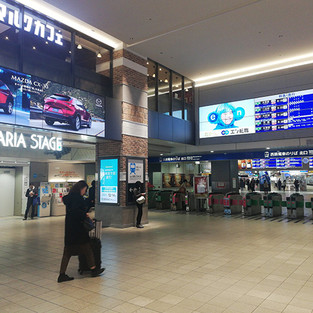How Should the Transportation Hub in CBD be Developed?
- LKP

- Jan 7, 2021
- 2 min read
Updated: Feb 9, 2021

A Fukuoka-based major transport operator, Nishitetsu, rebuilt a terminal building in the city center -- both train and bus terminals integrated into one structure with other functions without stopping its operation, almost in the same location to keep the impact on the area to a minimum. And the solutions to the problems in the area, such as traffic safety and congestion, were also considered.
You can watch this case in our 360-degree video!
Solaria Terminal Building
Tenjin is the center of Fukuoka City, as well as the business center of Kyushu Island. There is also the base of one of the major private railroad companies in Japan, Nishi-Nippon Railroad, or well known as Nishitetsu. It operates not only the trains but also local and highway buses, retail, and real estate businesses. Nishitetsu has been running its main train terminal since 1924, and bus terminals since 1961 in this area, Tenjin.
In 1986, the development project of this Tenjin area, named as Solaria Project, including the reconstruction of the terminal started, following the 6th Fukuoka City Master Plan. This project was a large-sized project totaling 120 billion yen, covering 18,500 square meters, and it was divided into 3 phases. The reconstruction of the Solaria Terminal Building, the terminal building with a department store and parking areas was in the 2nd phase from 1992 to September 1997, after the 1st phase construction of a retail and hotel building.
In this plan, two drawbacks that the old bus terminal being on the ground floor were considered. First, the bus terminal was moved to the 3rd floor of the building instead of the original ground level. And new several corridors were added on the ground level to create flows of people between the avenue with the high traffic volume in the city on the east side, and the park in the west.
Secondly, the entrance for the buses and cars coming into the terminal was changed from Watanabe Dori Avenue to the south border of the Tenjin Area, and the buses and cars coming in and out of this terminal would use the flyover on top of the railroad starting there. This move secured the safety of pedestrians and relieve traffic congestion in the area.
Most noteworthy is that this reconstruction of the Solaria Terminal Building was carried out without stopping trains and buses' operation even for one day. To keep the impact on the people and businesses in the area to a minimum, Nishitetsu operated the trains and buses almost at the same location, without building the temporary terminal in a nearby site that might have disrupted people's flow in and out of the terminal.
Solaria Terminal Building underwent a major facelift in 2015. It continues to evolve and operate as an essential transportation hub and the gateway of Tenjin or Fukuoka City even now, more than two decades after the project's completion.
[Case ID: Urban Renewal UR-02]































Comments